Straight Jacket Embrace

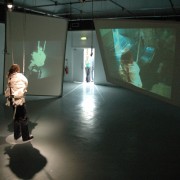
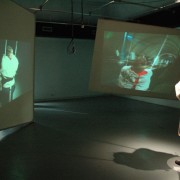
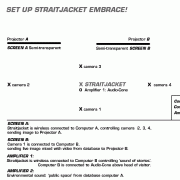
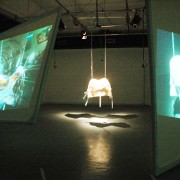
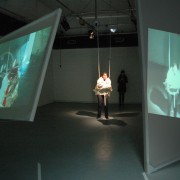
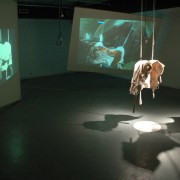
Interactive Video and RFID installation
Straitjacket Embrace! is both a self-surveillance system and a tool for storytelling; creating an audio-visual, immersive environment through embracing yourself.
Introduction - Straitjacket Embrace! deals with experiences of fear and desire for the other in contemporary public spaces. In our networked society the public space is no longer a space we can leave or exclude. Through mobile technologies – like mobile phone, RFID – the controlling gaze of public space is everywhere; in our private homes, our beds, and even in our bodies. Lancel and Maat research the networked gaze as a ‘participatory panopticon’. They explore the personal gaze and individual narratives of the connected body; the way we meet and embrace.
In their straitjacket Lancel and Maat turn a hidden RFID control system upside down into a private play-zone for your own body.
For Straitjacket Embrace! Lancel and Maat designed a ‘fictional public space’ with an interactive straitjacket as interface. Here they invite their audience. The interactive straitjacket is wearable, like a second skin, and provides the wearer with both the experience of play and a phobic ‘self-surveillance system’. The space around the straitjacket is sonically created around audible stories, while visually creating a surrealistic panopticon.
How does the straitjacket work? The Straitjacket hangs from the ceiling surrounded by camera's, audio feed and video projections. You are invited to put the straitjacket on and find both it’s enclosing functionality as well it’s natural invitation ‘to embrace yourself’. Through touching the straitjacket, your body becomes an interface. Invisibly in the front of the jacket the artists placed not one unique RFID tagbut a hundred of them for you to play with. You 'trace' yourself by putting both your arms in the jacket and embracing yourself; by a smart hidden little RFID reader invisibly attached to your hand in the jacket, to ‘read’ the RFID tags. By softly caressing yourself the RFID tags open their information for you.
Right hand Your right hand turns your body into a multi-channel radio-archive. Your body seems to contain intimate whispering voices of different people telling stories about trying to be safe in public space by being invisible and uncontrollable. For these stories Lancel and Maat had interviews with people who in some way feel excluded from the public space, like people living illegally in the city, prisoners, refugees and people dealing with mental health issues. The main question was: 'what is a safe place for you in public space?' The interviews lead to personal and intimate stories about the (im)possibility of creating an own safe place, and the often total dependency for this on strangers. In StraitJacket Embrace! your body contains a mediated memory for these stories on public space experiences.
Left hand With your left hand you activate projected live video images of yourself on the screens surrounding you. The images are generated by multiple cameras from different angles, connected to the RFID tags. Relating to each RFID tag, you manipulate these cameras, creating a surveillance system or Panopticon turned mad. While playing in the privacy of the straitjacket your image on the screens is mixed with live video feeds of an audience gazing at you from public space. Your video image is simultaneously presented on a screen in the museum entrance hall. Here ‘you’ gaze at the audience – and the audience gazes back, at both your exclusive situation as well as at their own reactions.
On RFID control technology For the interactive straitjacket Lancel and Maat use 'invisible technology' called RFID (radio frequency identification). RFID is a system that uses tiny little chip-with-sensors, RFID tags, that provide objects each with an unique identity. RFID creates a wireless network, nowadays used for (product) control and logistics. Through RFID, anonymous strangers can ‘trace’ your private life wherever you go without you ever knowing it. Today these tiny little RFID tags can be found almost everywhere – in our mobile phones, under the skin of our pats, in bracelets and anklets worn by people in prison.